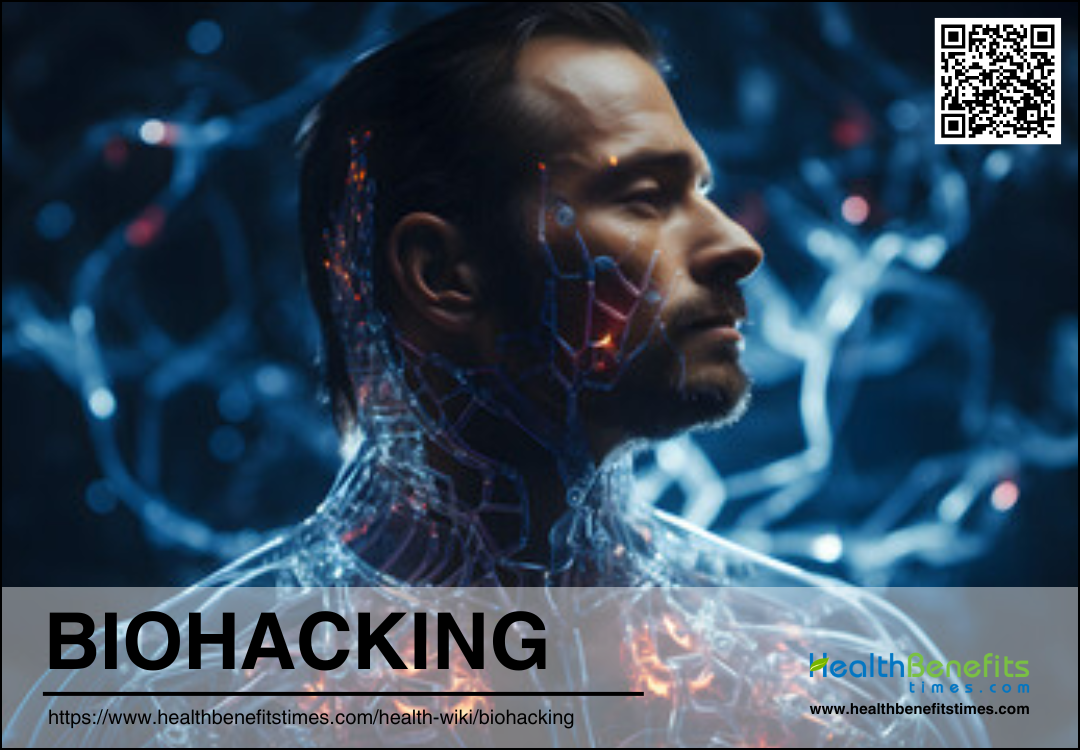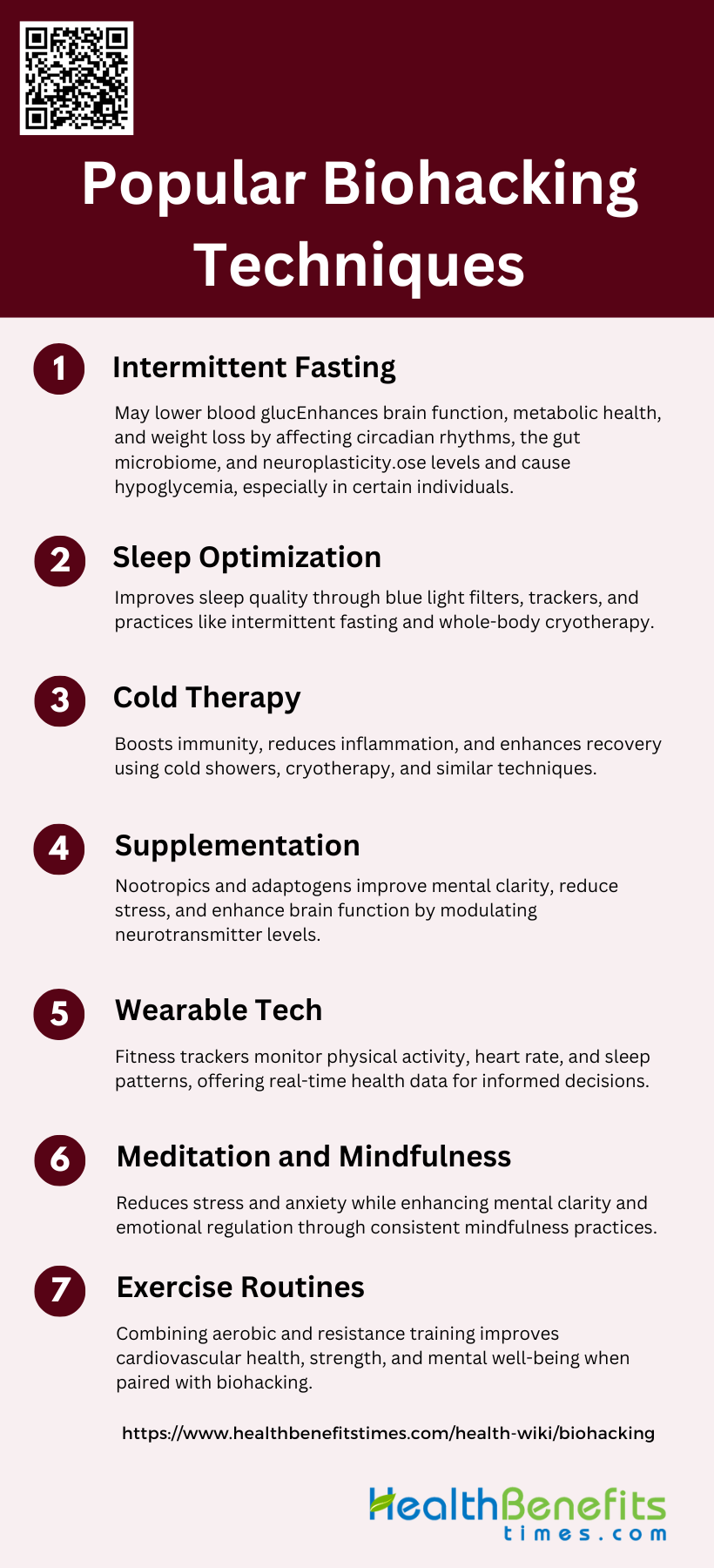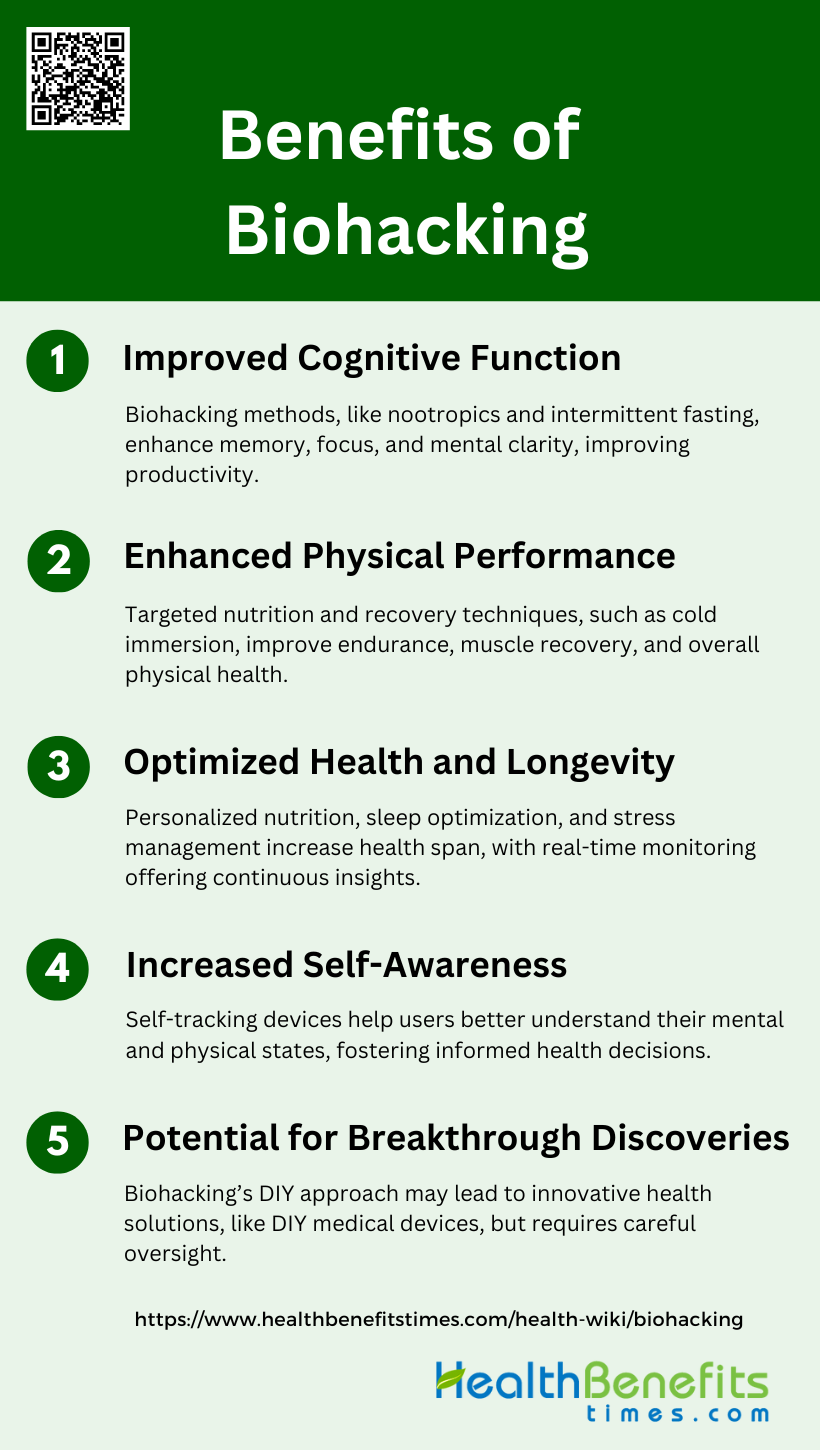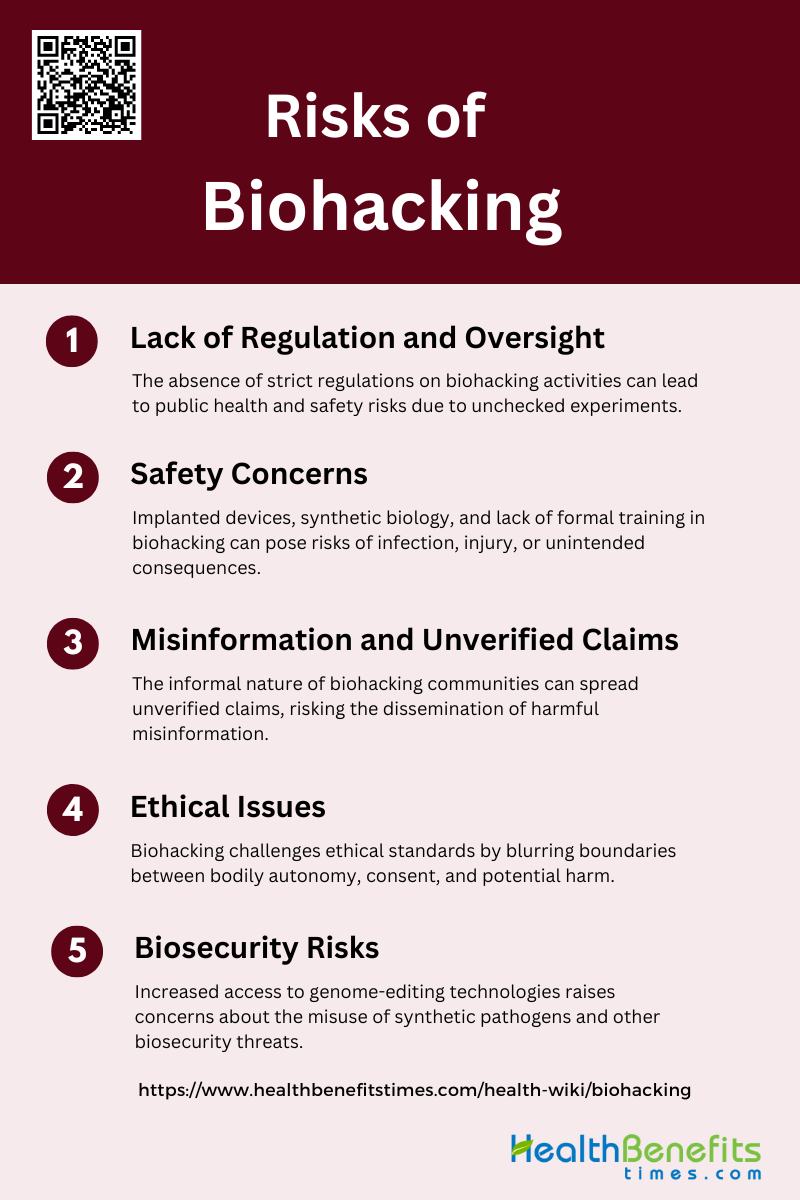Biohacking refers to the practice of using science and technology to enhance the capabilities of the human body, often through unconventional and experimental means. This can include the implantation of hardware into the body to achieve specific technological functions, such as subcutaneous magnets or LED clusters. The movement has grown significantly due to the increased accessibility of genetic engineering tools and the rise of do-it-yourself (DIY) biology, allowing amateurs to conduct experiments outside traditional academic or corporate settings. Biohacking encompasses a wide range of activities, from self-tracking and nootropics to more extreme forms like body modification and synthetic biology. While it offers potential benefits in terms of personal empowerment and innovation, it also raises significant ethical, legal, and health concerns, particularly regarding the safety and regulation of these practices.
The Science behind Biohacking
Biohacking operates by integrating various technological devices and biological modifications into the human body to enhance its capabilities. This can range from simple self-tracking and health tests to more complex procedures like implanting hardware to facilitate specific functions, such as subcutaneous magnets to interact with other devices. The role of biology and technology in biohacking is pivotal, as advancements in information and communication technologies, along with the availability of data and open-source models, have democratized access to genetic engineering tools and techniques, allowing even amateurs to participate in DIY biology. Examples of biohacking in action include the development of community labs for synthetic biology, the creation of open-source equipment like The Pearl Gel System, and the implantation of devices to track health metrics or enhance physical abilities. This movement not only empowers individuals to take control of their biological makeup but also raises important ethical and regulatory questions about safety and the potential for misuse.
Different types of biohacking
Biohacking encompasses a wide range of practices aimed at enhancing physical and mental performance. From dietary changes to genetic modifications, each type of biohacking offers unique methods and benefits. Below are some Different types of biohacking:
1. Nutritional Biohacking
Nutritional biohacking involves tailoring dietary intake to optimize health and performance. Personalized nutrition, which considers individual genetic profiles and metabolic biomarkers, has shown promise in improving health outcomes over generic dietary recommendations. Techniques such as intermittent fasting and time-restricted eating are gaining popularity for their potential to enhance metabolic health and support weight loss. Athletes, in particular, benefit from personalized nutrition plans that optimize performance and recovery by addressing specific nutritional needs and deficiencies.
2. Genetic Biohacking
Genetic biohacking leverages knowledge of an individual’s genetic makeup to optimize health and performance. Nutrigenomics and nutrigenetics are key areas, focusing on how genetic variations affect nutrient absorption, metabolism, and overall response to dietary interventions. Personalized nutrition based on genetic testing can help tailor dietary recommendations to improve health outcomes and athletic performance. This approach aims to move beyond one-size-fits-all guidelines, offering more precise and effective nutritional strategies.
3. Cybernetic Biohacking
Cybernetic biohacking involves integrating technology with the human body to enhance physical and cognitive abilities. This can include the use of wearable devices to monitor physiological parameters, implantable chips for health tracking, and even neural interfaces to augment brain function. While this area is still emerging, it holds potential for significant advancements in personalized health monitoring and performance optimization. The integration of cybernetic elements can provide real-time data, enabling more precise and immediate adjustments to health and fitness routines.
4. DIY Biology
DIY biology, or biohacking, is a movement where individuals and small groups conduct biological experiments outside traditional research institutions. This can range from genetic modifications to creating personalized supplements. The DIY approach democratizes science, allowing enthusiasts to explore and innovate in areas like personalized nutrition and genetic engineering. However, it also raises ethical and safety concerns, as unregulated experiments can lead to unintended consequences. Despite these challenges, DIY biology continues to grow, driven by the increasing accessibility of scientific tools and knowledge.
Popular Biohacking Techniques
Biohacking involves making small, incremental changes to your lifestyle to improve your health and well-being. From dietary adjustments to advanced technology, these techniques can help optimize various aspects of your life. Below are some popular biohacking techniques:
1. Intermittent Fasting
Intermittent fasting (IF) has been shown to promote weight loss and improve metabolic health by influencing circadian biology, the gut microbiome, and lifestyle behaviors such as sleep. IF also enhances brain function and resilience by inducing metabolic switching, which promotes neuroplasticity and resistance to stress, injury, and disease. Additionally, IF can improve cognitive function and alleviate diabetes-induced cognitive impairment through the gut microbiota-metabolites-brain axis.
2. Sleep Optimization
Using blue light filters and sleep trackers can help improve sleep quality by reducing exposure to disruptive light and monitoring sleep patterns. Weight loss through intermittent fasting can also improve sleep quality by reducing inflammatory cytokines that disturb the sleep/wake cycle5. Whole body cryotherapy (WBC) after evening exercise has been shown to enhance sleep quality by reducing nighttime movements and improving heart rate variability during sleep.
3. Cold Therapy
Cold therapy, including cold showers and cryotherapy, can boost the immune response by reducing inflammation and enhancing recovery. Whole body cryotherapy (WBC) has been found to improve sleep quality and reduce pain, which may contribute to better overall health and immune function.
4. Supplementation
Nootropics and adaptogens are supplements that can enhance mental clarity and reduce stress. These substances work by modulating neurotransmitter levels, improving brain function, and increasing resistance to stress. While specific studies on nootropics and adaptogens were not provided, their general benefits are well-documented in the biohacking community.
5. Wearable Tech
Fitness trackers and smart devices are essential tools for health monitoring. They provide real-time data on physical activity, heart rate, sleep patterns, and other vital signs, enabling users to make informed decisions about their health and wellness. These devices can help optimize exercise routines, sleep quality, and overall health.
6. Meditation and Mindfulness
Meditation and mindfulness practices are effective biohacking techniques for reducing stress, improving mental clarity, and enhancing overall well-being. These practices can modulate brain activity, reduce anxiety, and improve emotional regulation, contributing to better mental and physical health.
7. Exercise Routines
Regular exercise is a cornerstone of biohacking, offering numerous benefits for physical and mental health. Exercise routines that include both aerobic and resistance training can improve cardiovascular health, enhance muscle strength, and boost mood. Combining exercise with other biohacking techniques, such as intermittent fasting and cold therapy, can further amplify these benefits.
How to Start Biohacking
Setting Goals
Setting clear and achievable goals is a fundamental step in biohacking. Defining personal outcomes helps individuals tailor their biohacking efforts to meet specific health and lifestyle objectives. This involves a thorough analysis of one’s current lifestyle and health status to identify areas for improvement. For instance, understanding one’s baseline health metrics can guide the selection of appropriate biohacking techniques and interventions. By setting specific, measurable, attainable, relevant, and time-bound (SMART) goals, individuals can create a structured plan that enhances motivation and tracks progress effectively. This approach ensures that biohacking efforts are purposeful and aligned with personal health aspirations.
Monitoring and Tracking Progress
Monitoring and tracking progress are crucial components of successful biohacking. Utilizing tools and technologies such as health-tracking apps and wearable devices can provide real-time data on various health metrics, including physical activity, sleep patterns, and dietary intake. Popular apps like MyFitnessPal and wearables like Fitbit offer user-friendly interfaces and automated tracking features that simplify the process of logging and analyzing health data. Establishing a feedback loop through these technologies allows individuals to receive personalized, actionable suggestions that promote healthier behaviors. For example, the My Behavior app uses a combination of manual and automatic logging to generate tailored recommendations, which have been shown to improve physical activity levels and dietary choices.
Benefits of Biohacking
Biohacking offers numerous advantages that can significantly improve various aspects of life. From cognitive enhancements to physical performance, these techniques provide a holistic approach to well-being. Here are some key benefits of biohacking:
1. Improved Cognitive Function
Biohacking techniques aimed at enhancing cognitive function have shown promising results. Methods such as nootropic supplementation, intermittent fasting, and neurofeedback can potentially improve memory, focus, and mental clarity. Some biohackers report increased productivity and creativity as a result of these interventions. However, it’s important to note that the effectiveness of these techniques can vary among individuals, and more research is needed to fully understand their long-term impacts on brain health and cognitive performance.
2. Enhanced Physical Performance
Biohacking approaches to physical performance optimization include targeted nutrition, advanced exercise protocols, and recovery techniques. Cold water immersion, for instance, has been shown to improve short-term recovery of endurance performance and longer-term recovery of jump performance and strength. Additionally, the use of supplements like niacinamide and coenzyme Q10 can contribute to maintaining skin cell vitality and combating inflammatory stressors, potentially enhancing overall physical well-being.
3. Optimized Health and Longevity
Biohacking strategies for health optimization and longevity often focus on personalized nutrition, sleep optimization, and stress management. Some biohackers explore advanced techniques like genetic testing and microbiome analysis to tailor their health interventions. The integration of wearable technology allows for continuous monitoring of vital signs and biomarkers, enabling real-time adjustments to lifestyle factors. While promising, it’s crucial to approach these methods with caution and consult healthcare professionals when considering significant changes to one’s health regimen.
4. Increased Self-Awareness
Biohacking can lead to heightened self-awareness through various tools and methods. Self-tracking devices and apps allow individuals to monitor their physical and mental states, providing insights into personal patterns and triggers. This increased understanding can lead to more informed decision-making regarding health and well-being. For leaders, particularly in fields like nursing, developing self-awareness is crucial for identifying strengths and weaknesses, navigating complexities, and fostering positive relationships.
5. Potential for Breakthrough Discoveries
Biohacking’s DIY approach has the potential to lead to unexpected breakthroughs in health and science. For example, research on bottlenose dolphins at the Navy Marine Mammal Program led to surprising discoveries about diabetes-like states in these animals, potentially offering new insights into human diabetes. Additionally, the democratization of biology through biohacking activism has challenged norms in healthcare, such as the development of DIY insulin and EpiPens, which could potentially lead to more accessible and affordable medical solutions.
Risks of Biohacking
While biohacking offers numerous benefits, it also comes with several risks that must be carefully considered. From safety concerns to ethical dilemmas, these risks can have significant implications. Here are some of the primary risks associated with biohacking:
1. Lack of Regulation and Oversight
Biohacking, which involves conducting biological experiments outside traditional scientific settings, often lacks adequate regulation and oversight. This is particularly concerning given the potential risks to public health and safety. While professional scientific research is subject to robust regulatory frameworks, biohacking activities are not as closely monitored, leading to potential regulatory failures. The accessibility and affordability of genome-editing technologies have made biohacking more prevalent, yet the mechanisms to regulate these activities are often absent or inadequate. This regulatory gap poses significant challenges, as it may allow for the unchecked proliferation of potentially hazardous biological experiments.
2. Safety Concerns
The rapid advancements in synthetic biology and biohacking have introduced numerous safety concerns. These include risks to participant safety, biosafety, and biosecurity. For instance, the implantation of hardware into the body, a common biohacking practice, raises questions about the clinical significance and safety of such devices, including their compatibility with medical procedures and potential for causing infections. Additionally, the lack of formal scientific training among many biohackers exacerbates these safety risks, as they may not fully understand the implications of their experiments. Addressing these safety concerns requires stringent ethical governance and adherence to principles such as non-maleficence and reasonable risk control.
3. Misinformation and Unverified Claims
Biohacking communities often operate in a decentralized and informal manner, which can lead to the spread of misinformation and unverified claims. Online platforms where biohackers share their experiences and findings may lack rigorous scientific validation, leading to the dissemination of potentially harmful or misleading information. This is particularly problematic given the complex and technical nature of biological experiments, which require a high level of expertise to conduct and interpret accurately. The absence of peer review and formal oversight in these communities further exacerbates the risk of misinformation, potentially endangering public health and safety.
4. Ethical Issues
Biohacking raises numerous ethical issues, particularly concerning bodily autonomy, consent, and the potential for harm. The practice often involves modifying one’s own body or conducting experiments on oneself, which can blur the lines between personal freedom and ethical responsibility. Additionally, the lack of formal ethical review processes in biohacking activities means that potentially harmful experiments may be conducted without adequate consideration of their ethical implications. The rise of biohacking also challenges traditional norms and regulations in science, necessitating a reevaluation of ethical standards to address the unique issues posed by this emerging field.
5. Biosecurity Risks
The increasing accessibility of synthetic biology and genome-editing technologies has heightened biosecurity risks. The potential for the intentional misuse of synthetic pathogens, such as resurrecting extinct viruses, poses significant threats to global security. The spread of know-how and the availability of biological parts and instruments make it easier for malicious actors to exploit these technologies for bioterrorism. Open science practices, while beneficial for scientific progress, can also exacerbate these risks by making sensitive information more accessible. Therefore, it is crucial to implement stringent biosecurity measures and oversight to mitigate these risks while balancing the need for scientific openness.
6. Overemphasis on Optimization
Biohacking often emphasizes the optimization of human capabilities, sometimes at the expense of safety and ethical considerations. This focus on enhancement can lead to risky and untested interventions, such as the implantation of devices or the use of unverified genetic modifications. The pursuit of optimization may also overshadow the importance of addressing fundamental safety and ethical issues, leading to potentially harmful consequences. Moreover, the cultural narrative around biohacking, which often glorifies extreme forms of body modification and self-experimentation, can encourage individuals to undertake dangerous practices without fully understanding the risks involved. It is essential to balance the drive for optimization with a commitment to safety, ethics, and responsible scientific conduct.
The Future of Biohacking
The future of biohacking is poised to revolutionize various fields through emerging trends such as genetic modification, CRISPR, and microbiome hacking. CRISPR technology, in particular, has democratized genetic editing, allowing both professional scientists and amateur biohackers to make precise modifications to DNA, which could lead to groundbreaking advancements in medicine and longevity research. For instance, CRISPR-based tools are being used to edit the genomes of gut microorganisms, potentially leading to new treatments targeting the microbiome. Additionally, genetically engineered bacteria are being explored for targeted drug delivery, offering promising applications in personalized medicine and cancer therapy. These innovations are not only pushing the boundaries of scientific research but are also influencing the personal wellness industry by enabling the development of next-generation probiotics and functional foods designed to enhance human health. As biohacking continues to evolve, it holds the potential to significantly impact public health, necessitating careful consideration of ethical and regulatory frameworks to ensure safe and equitable access to these powerful technologies.
Ethical and Legal Considerations for Biohacking
Biohacking, which involves the integration of technology into the human body to enhance capabilities, presents significant ethical and legal challenges. Ethically, biohacking raises concerns about human enhancement and data privacy. The integration of technology into the human body, as explored by biohackers, often aims to transcend human limitations, but this pursuit can lead to ethical dilemmas related to eugenics and human commodification. Additionally, the use of biometric data in biohacking necessitates stringent data privacy measures to protect individuals’ personal information, as misuse can lead to discrimination and identity theft. Legally, the landscape is complex and varies by region. While some biohacking activities are permitted, others, particularly those involving genetic modifications, face strict regulations due to potential public health risks. The legal framework often emphasizes informed consent, confidentiality, and the ethical use of human tissue, reflecting broader concerns about bodily integrity and autonomy. These ethical and legal considerations are crucial as they help balance innovation with the protection of individual rights and public safety.
FAQs
1. What are the legal implications of biohacking?
Biohacking, especially genetic modifications and implantations, often falls in a gray area legally. In many countries, performing biohacks without proper medical or ethical oversight could violate health regulations. It’s important to be aware of local laws and regulations, as some biohacking practices, such as genetic engineering on humans or the use of unapproved substances, could result in legal consequences.
2. How does biohacking differ from traditional medical treatments?
Biohacking typically involves self-experimentation, unregulated practices, or DIY biology outside formal medical frameworks. Traditional medical treatments are subject to rigorous testing, clinical trials, and approval processes by regulatory bodies, whereas biohacking often lacks formal oversight.
3. What are the long-term health risks associated with biohacking?
Long-term risks of biohacking are largely unknown, especially since many biohacking techniques lack comprehensive studies. Modifying the body using untested technologies or substances could lead to unforeseen health complications, including chronic conditions, immune system interference, or even life-threatening consequences.
4. Can biohacking improve mental health conditions like anxiety or depression?
While some biohacking techniques, such as meditation, mindfulness, and nootropic supplementation, claim to enhance mental clarity and reduce stress, there is limited evidence on their effectiveness for treating mental health conditions like anxiety or depression. People with these conditions should consult medical professionals before trying biohacking techniques as a solution.
5. What is the role of the gut microbiome in biohacking?
The gut microbiome is a critical focus area in biohacking, as many biohackers believe that optimizing gut health can lead to improved immunity, cognitive function, and overall wellness. Techniques like personalized nutrition, prebiotics, and probiotics are used to support a healthy gut microbiome.
6. Are there any ethical concerns related to biohacking?
Yes, there are significant ethical concerns, particularly regarding privacy, the potential for unequal access to biohacking technologies, and the long-term societal impact of human enhancement. Modifying one’s genetics or body through unregulated practices can also pose moral dilemmas.
7. Is biohacking expensive?
Biohacking can range from low-cost methods, such as intermittent fasting and meditation, to expensive technologies like wearable health trackers, genetic testing, and implantable devices. The costs largely depend on the type of biohacking one chooses to pursue.
8. How do biohacking practices impact environmental sustainability?
Some biohacking techniques, such as genetically modifying organisms, could raise concerns about environmental sustainability. There is debate over whether certain biohacking experiments, especially DIY genetic engineering, may have unintended ecological effects if not properly regulated.
9. How does biohacking influence the future of healthcare?
Biohacking could pave the way for more personalized, proactive healthcare approaches. By using self-monitoring and genetic tools, individuals might prevent illnesses before they arise. However, this also raises concerns about the blurring lines between medical professionals and laypeople experimenting with biology.
10. Is biohacking safe for children or teenagers?
Due to the experimental nature of many biohacking practices, it is generally not recommended for children or teenagers. Their bodies are still developing, and interventions such as nootropic supplementation or genetic modification could have unpredictable consequences. It’s important to consult healthcare providers for age-appropriate health interventions.





